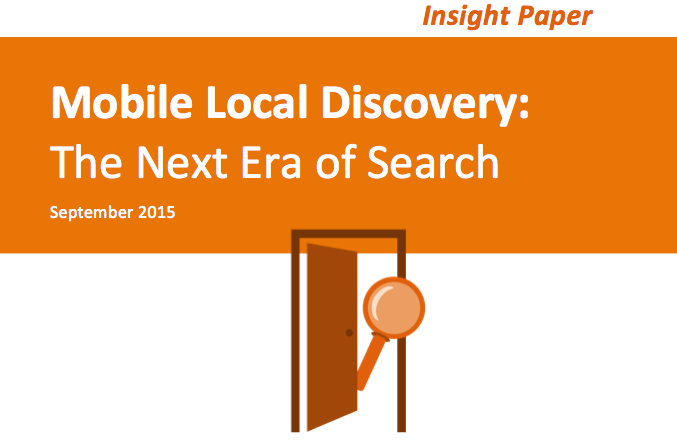
This post is the latest in a weekly series of excerpts from BIA/Kelsey’s recent report Mobile Local Discovery, The Next Era of Search. The series will lead up to BIA/Kelsey NEXT, a conference on the future of local, taking place December 9th & 10th in Los Angeles.
What happens to search when the browser is no longer the front door? As engagement migrates to mobile, users’ front door is predominantly apps instead of the search-centric web. This is the topic of a new BIA/Kelsey report, Mobile Local Discovery, The Next Era of Search.
Search started in the desktop-heavy world of the 90’s and 2000’s, when trillions of web pages compelled an advanced index and a friendly entry point. But an app-centric mobile universe — pre-organized into neat little buckets — doesn’t compel a search engine, as we know it.
Our report looks at the state of mobile search. How is it impacted by new hardware (i.e. wearables), software innovation (Google Now) and shifting user behavior (i.e. millennials)? What will Google and others do to live in this new multi-screen world? And what will be the next decade’s local search business models?
Our last installment examined Google Now and what makes it tick. We pick up this week with the report’s chapter on quantifying the online-to-offline opportunity. It’s central to all mobile products or ads looking to tap into the local opportunity. The excerpt is below, and a bonus slide presentation sits below that.
The Endgame: A $7 Trillion Market
Google’s efforts with Now are aligned with a parallel initiative where it’s placing many chips: offline commerce. This can be seen in its Estimated Total Conversions effort to build better analytics around how online and mobile user engagement results in real offline conversions.
The reason this opportunity is important simply comes down to its size. Despite e-commerce’s attention and fame, it only accounts for about 7 percent of U.S. retail spending, according to the U.S. Census Bureau. The other 93 percent happens offline, and nearly 100 percent of local services happen offline.
In total, this accounts for about $7 trillion in U.S. consumer spending, according to BIA/Kelsey estimates. But more importantly, $2 trillion of that is influenced in mobile. So the name of the game is driving offline conversions from engagement points that originate on smartphones.
This opportunity is rich in mobile because of users’ higher purchase intent when compared with desktop. There is also a greater chance that mobile users are at or near a store and receptive to commerce-oriented push alerts and Google Now cards, such as the Home Depot example below.
Another example is PetSmart. By using Google’s Estimated Store Visits, it learned that 10 percent to 18 percent of search ad clicks led to a store visit. This realization informed the decision to increase the use of location extensions — the tool that was driving the most store visits — in its search campaigns.
Close to all this is Brendon Kraham, Google’s director of emerging ad sales and product strategy, who is in charge of “building and developing Google’s next $1 billion+ ad businesses.” That’s a big task, and Kraham is examining ways to extend Google’s capabilities, data and search dominance into this new mobile-oriented world.
In addition to the above products, this involves carrying forward Google’s legacy of innovation in performance-based local ads. In mobile, that translates to offline attribution, a la Estimated Total Conversions. This is just one way Google is planting its flag in the next decade’s ad equation.
“It’s still early, but I can see the future that is coming and even now we have the proxy metrics of ‘did somebody go into a store’ and actually closing the loop with third-party data for a store transaction,” Kraham told BIA/Kelsey. “It just takes a bit more heavy lifting to get those insights.”
M-Commerce
Even though offline commerce is the larger revenue opportunity, Google is still interested in having its mobile products drive online purchases (m-commerce). This follows a pattern in Google’s strategic moves of placing several bets to diversify its overall opportunity.
Recent moves to boost m-commerce include buy buttons placed within results pages on mobile searches. Known as “Purchases on Google,” these buttons are coupled with its Product Listings Ads, lowering friction for users to buy items directly within search results.
This program is in a pilot phase with a few select partners. In the future it will open up to more advertisers but require that they integrate ordering systems with Google. “Buy” buttons will then take users to a merchant-branded transactional landing page hosted by Google.
Google won’t take a transaction fee (as Amazon does) but will benefit from how the program makes search ads more attractive by clarifying ROI. It hopes this will make conversions more transparent and boost its core search advertising business, where all other roads lead.
Buy buttons interestingly position Google as more of an endpoint for online commerce, rather than its traditional role as a launch point to third-party content. They’re bound to be controversial for that reason but are a logical move given the lowered friction for small-screen purchases.
Moreover, this move fits an ongoing theme in in this report that Google’s priority is to maintain its front-door position to information and commerce, wherever it’s happening. Indeed, buy buttons for retail partners are conceptually similar to deep links to third-party content and apps.
________
BIA/Kelsey Clients can log in to download the report, and others can read more and purchase the full report in the BIA/Kelsey eStore.

This Post Has 0 Comments